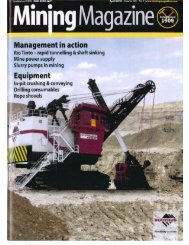clamp-on, sonar-based volumetric flow rate and gas ... - CiDRA
clamp-on, sonar-based volumetric flow rate and gas ... - CiDRA
clamp-on, sonar-based volumetric flow rate and gas ... - CiDRA
You also want an ePaper? Increase the reach of your titles
YUMPU automatically turns print PDFs into web optimized ePapers that Google loves.
Flomeko 2005<br />
6 – 9 June 2005<br />
S<strong>on</strong>ar <strong>flow</strong> meters use an approach developed <strong>and</strong> commercialized specifically for multiphase<br />
<strong>flow</strong> measurement in the oil <strong>and</strong> <strong>gas</strong> industry in which multiphase challenges described above<br />
are routinely encountered. S<strong>on</strong>ar meters measure the propagati<strong>on</strong> velocity of operati<strong>on</strong>ally<br />
gene<strong>rate</strong>d sound in the ~100 to 1000 Hz frequency range. In this frequency range, sound<br />
propagates as a <strong>on</strong>e-dimensi<strong>on</strong>al wave, using the process pipe as a wave-guide. The<br />
wavelength of sound in this frequency range (>1 m) is typically several orders of magnitude<br />
larger than the length scale of the any bubbles or <strong>flow</strong> n<strong>on</strong>-uniformities. The l<strong>on</strong>g wavelength<br />
acoustics propagate through multiphase mixtures unimpeded, providing a robust <strong>and</strong><br />
representative measure of the <strong>volumetric</strong>ally averaged properties of the <strong>flow</strong>.<br />
For the sound speed measurement, the s<strong>on</strong>ar <strong>flow</strong> meter utilizes similar processing<br />
algorithms as those employed for the <strong>volumetric</strong> <strong>flow</strong> measurement. As with c<strong>on</strong>vective<br />
disturbances, the temporal <strong>and</strong> spatial frequency c<strong>on</strong>tent of sound propagating within the<br />
process piping is related through a dispersi<strong>on</strong> relati<strong>on</strong>ship.<br />
kc<br />
(6).<br />
As before, k is the wave number, defined as k=2π/λ (1/m), ω is the temporal frequency (rad/s),<br />
<strong>and</strong> c is the speed at which sound propagates within the process piping. Unlike disturbances<br />
which c<strong>on</strong>vect with the <strong>flow</strong>, however, sound generally propagates in both directi<strong>on</strong>s, with <strong>and</strong><br />
against the mean <strong>flow</strong>. For these cases, the acoustic power is located al<strong>on</strong>g two acoustic<br />
ridges, <strong>on</strong>e for the sound traveling with the <strong>flow</strong> at a speed of c + V <strong>and</strong> <strong>on</strong>e for the sound<br />
traveling against the <strong>flow</strong> at a speed of c - V.<br />
Figure 7: k-w plot for 3% entrained air in water.<br />
Figure 7 shows a k- ω plot<br />
gene<strong>rate</strong>d for acoustic sound field<br />
recorded from still water c<strong>on</strong>taining<br />
~3% entrained air by volume in an<br />
8 in, schedule 80, vertically<br />
oriented Plexiglas pipe. The k-w<br />
plot was c<strong>on</strong>structed using data<br />
from an array of strain <strong>based</strong><br />
sensors <str<strong>on</strong>g>clamp</str<strong>on</strong>g>ed to the outside of<br />
the pipe. Two acoustic ridges are<br />
clearly evident. Based <strong>on</strong> the<br />
slopes of the acoustic ridges, the<br />
measured sound speed for this for<br />
this mixture was 70 m/s, c<strong>on</strong>sistent<br />
with that predicted by the Wood<br />
equati<strong>on</strong>. Note that adding 3% air<br />
by volume reduces the sound<br />
speed of the bubbly mixture to less<br />
than 10% of the sound speed of<br />
liquid <strong>on</strong>ly water.<br />
4.3 Industrial applicati<strong>on</strong>s<br />
As was menti<strong>on</strong>ed in the introducti<strong>on</strong>,<br />
there are two applicati<strong>on</strong>s of the full bore measurement<br />
of entrained <strong>gas</strong> of distinctly different character. First there are those where process aerati<strong>on</strong><br />
must be c<strong>on</strong>trolled or where process aerati<strong>on</strong> must be avoided altogether. Examples of such<br />
are:<br />
Natural froth lubricity <strong>flow</strong>s.<br />
s.<br />
erages.<br />
per machine’s headbox 15 Gas sparging in flotati<strong>on</strong> cell<br />
Dissolving carb<strong>on</strong> dioxide in bev<br />
Entrained air in the thin stock <strong>flow</strong> to a pa<br />
.<br />
Entrained air in filling stati<strong>on</strong>s for domestic household products.<br />
Sec<strong>on</strong>d there are applicati<strong>on</strong>s where entrained <strong>gas</strong>es negatively affect the process indirectly<br />
by affecting other types of meters. Examples of this sec<strong>on</strong>d kind are:<br />
BI0197 RevB 8



